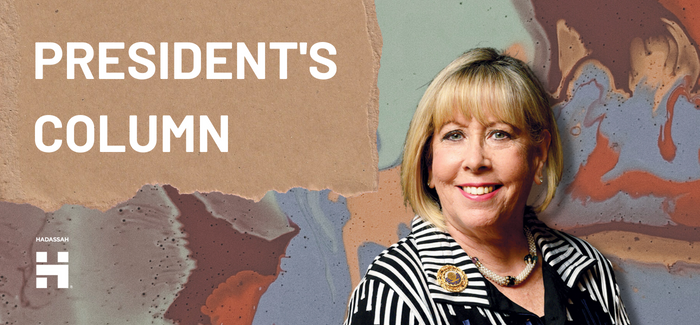Hadassah
President's Column
Restoring the Bedrock of Hadassah Activism

Just as the earth circles the sun, so does the Jewish calendar return to the same place every year. At the end of this High Holiday season, we will begin again, as always, with the reading of Bereishit, the first book of the Hebrew Bible.
As the book’s English title, Genesis, indicates, the first chapters of our story have a lot to do with generations. Derived from our biblical culture, “from generation to generation” is a common phrase in Jewish discourse that describes how heritage is handed down through the ages. The phrase applies equally to our collective destiny and to individual families, as parents pass teachings and values to children, and then it becomes the children’s turn to lead.
Real life, of course, often defies neat categories. In political, communal and cultural leadership, one generation doesn’t automatically withdraw as the next comes of age. At Hadassah, we recognize that it’s not one generation leading at a time, but members and leaders from various generations working together.
But something has happened in the past century that largely coincides with Hadassah’s history, a revolution unprecedented in human existence that we are all aware of on one level but that doesn’t always filter into our practical thinking.
When Henrietta Szold gaveled the first Hadassah meeting to order, she was 52 years old. She was on the mature side of the group she led, but that same age would put her on the younger side of Hadassah’s national leadership today. The rest of Hadassah’s first eight national presidents were under 50 when they assumed the highest office. Rose Halprin, who began her first term in 1932, was 36.
The revolution I alluded to is at the heart of this story. It’s about longevity. When Hadassah began in 1912, life expectancy for American women stood at 55. Today, it’s 81.
There’s a word for that 26-year gap: Generation.
Like much of the world, Hadassah has an additional generation of women to draw on, many of whom remain active at ages that their grandmothers and great-grandmothers barely dreamed of. It’s natural that we should take advantage of an entire generation’s rich experience and memory.
But it’s unnatural to allow one generation’s strength to eclipse the energy and the longer horizon of younger generations. When we bring younger women into our organization, they are not only adding a new dimension to our ranks but also restoring the age profile that was once the bedrock of Hadassah activism.
So let’s always remember not only what we offer to young women but also what they bring to us.
This is why Evolve Hadassah, our program for engaging and empowering young activists, is so critical. This is why it’s so important for us to take advantage of the strengths they have and also to train them for leadership. We’re all familiar with the saying, “There’s no better way to learn something than to teach it.” By training young leaders, our overall organization, advocacy and outlook become sharper.
Increased longevity is such an incredible gift to humanity, but we must figure out how to share the benefits. This is not to knock my own generation (I am 69) but to challenge all of us to do more. No business, institution or philanthropy will survive if it allows one generation to define it by default, or because it doesn’t master the art of making itself relevant and attractive to newcomers.
Bringing in larger numbers of young women not only ensures Hadassah’s future. It is also the optimal way to operate today, harnessing the layered power of all ages to direct our projects and advocate for women’s issues, to support Israel, combat antisemitism and all forms of hate, and express our values.
Let’s make sure in this New Year that after starting at Bereishit we don’t skip any generations. Let’s make sure we harness the power of all.
Shanah tovah!








 Facebook
Facebook Instagram
Instagram Twitter
Twitter
Leave a Reply